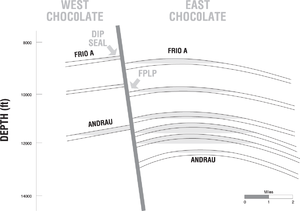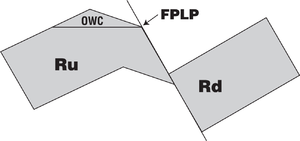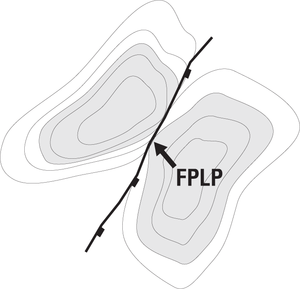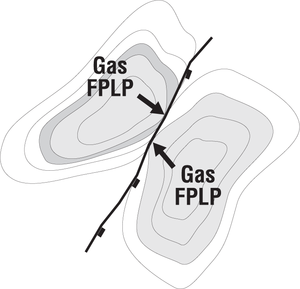Dip-leaking fault
| Exploring for Oil and Gas Traps | |

| |
| Series | Treatise in Petroleum Geology |
|---|---|
| Part | Predicting the occurrence of oil and gas traps |
| Chapter | Evaluating top and fault seal |
| Author | Grant M. Skerlec |
| Link | Web page |
| Store | AAPG Store |
A fault is dip leaking if hydrocarbons have migrated along the fault plane. Dip-leaking faults can be identified by the presence of a fault plane leak point (FPLP).
Fault plane leak point (FPLP)
An FPLP is a type of fault-dependent leak point in which the hydrocarbon contact coincides with the intersection of the fault plane and the top of the reservoir. As shown in Figure 1, an FPLP limits the hydrocarbon to the structurally independent closure. The lack of hydrocarbons in contact with the fault plane implies leakage has occurred vertically along the fault.[1][2][3]
The ability to predict leakage is important in prospect assessment. An FPLP limits the hydrocarbon volume. Where no independent closure exists, prospects may be completely emptied by dip leakage.
Asymmetric dip leakage
Afault may dip seal on one side of a fault and dip leak on the other. This asymmetric dip leakage is caused primarily by variations in the sand-shale ratio of the fault gouge. Other possible controls in some basins include asymmetric fracture density and/or preferential hydraulic fracturing in the hanging wall.[4][5]
Example of asymmetric dip leakage

An example of asymmetric dip leakage is the Chocolate Bayou field, U.S. Gulf Coast, shown in Figure 2. All of the hanging wall gas accumulations are limited by FPLPs and dip leak. The three gas accumulations in the footwall, however, are all dip sealing; all have gas columns in contact with the fault plane. This pattern of behavior is common in both the U.S. Gulf Coast and the Niger Delta.[4]
Low-side traps
Low-side traps may have very different fault seal risk compared with high-side traps. In Figure 3, a map shows that dip leakage in the hanging wall limits fill (shaded) to the structurally independent closure. Dip seal in the footwall allows fill in excess of the independent closure. The footwall contains purely fault-dependent traps. The hanging wall relies upon independent closure for entrapment.
Dip leakage of gas vs. oil
A fault may dip seal oil and dip leak gas or vice versa. The illustration in Figure 4 shows a fault that is dip leaking to gas in both the hanging wall and footwall. Both gas accumulations are limited by an FPLP. The oil accumulation in the footwall, however, is filled beyond the structurally independent closure. The fault is dip sealing to oil but dip leaking to gas.
Direction of dip leakage
Although dip leakage is generally understood as the migration up the fault zone due to buoyant forces, leakage down the fault zone can also occur. Refraction of flow lines can occur when fluids cross a fault zone of differing permeability from the wall rock. Fluid flow across a fault of lower permeability than the adjacent wall rock could dip leak down the fault zone.[7] Similarly, a fault zone with higher permeability than the wall rock will refract flow lines up the fault zone. Pressure differences along and across faults can also cause down-dip flow in the area of lowest pressure.[8][9]
Caveat
Faults in most basins are at equilibrium. Those faults that were going to leak have leaked. The present structure and juxtapositions control fault seal behavior and spill points. However, disequilibrium may exist in basins now undergoing rapid migration and fill. The Los Angeles basin (California) is one example. Faults may be dip leaking, but the rate of charge is greater than the rate of leakage. These faults appear to dip seal—despite seeps along the surface trace of the faults, which indicate dip leakage.
See also
- Fault seal behavior
- Cross-leaking faults
- Cross-sealing faults
- Dip-sealing faults
- Percent fill: controlling factors
References
- ↑ Smith, D. A., 1966, Theoretical considerations of sealing and non-sealing faults: AAPG Bulletin, vol. 50, no. 2, p. 363–374.
- ↑ Allard, D. M., 1993, Fault leak controlled trap fill, rift basin examples (abs.), in J. Ebanks, J. Kaldi, and C. Vavra, eds., Seals and Traps: A Multidisciplinary Approach: AAPG Hedberg conference, Crested Butte, Colorado, June 21–23.
- ↑ Harding, T. P., and A. C. Tuminas, 1988, Interpretation of footwall (lowside) fault traps sealed by reverse faults and convergent wrench faults: AAPG Bulletin, vol. 72, no. 7, p. 738–757.
- ↑ 4.0 4.1 Weber, K. J., G. Mandl, W. F. Pilaar, F. Lehner, and R. G. Precious, 1978, The role of faults in hydrocarbon migration and trapping Nigerian growth fault structures: Proceedings, Offshore Technology conference, Houston, p. 2643–2652.
- ↑ Skerlec, G. M., 1990, SEALS: A short course for risking top seal and fault seal: Franklin, Pennsylvania, SEALS International, 600 p.
- ↑ Myers, J. D., 1968, Differential pressures: a trapping mechanism in Gulf Coast oil and gas fields: Gulf Coast Assoc. of Geologists Transactions, vol. 18, p. 56–80.
- ↑ Hubbert, M. K., 1953, Entrapment of petroleum under hydrodynamic conditions: AAPG Bulletin, vol. 37, no. 8, p. 1954–2026.
- ↑ Knutson, C. A., and R. Erga, 1991, Effect of horizontal and vertical permeability restrictions in the Beryl reservoir: Journal of Petroleum Technology, vol. 43, p. 1502–1509., 10., 2118/19299-PA
- ↑ Niemann, J., and M. Krowlow, 1992, Delineation of a pressure fault seal from shale resistivities, in J. Ebanks, J. Kaldi, and C. Vavra, eds., Seals and Traps: A Multidisciplinary Approach: AAPG Hedberg Research conference, unpublished abstract.


